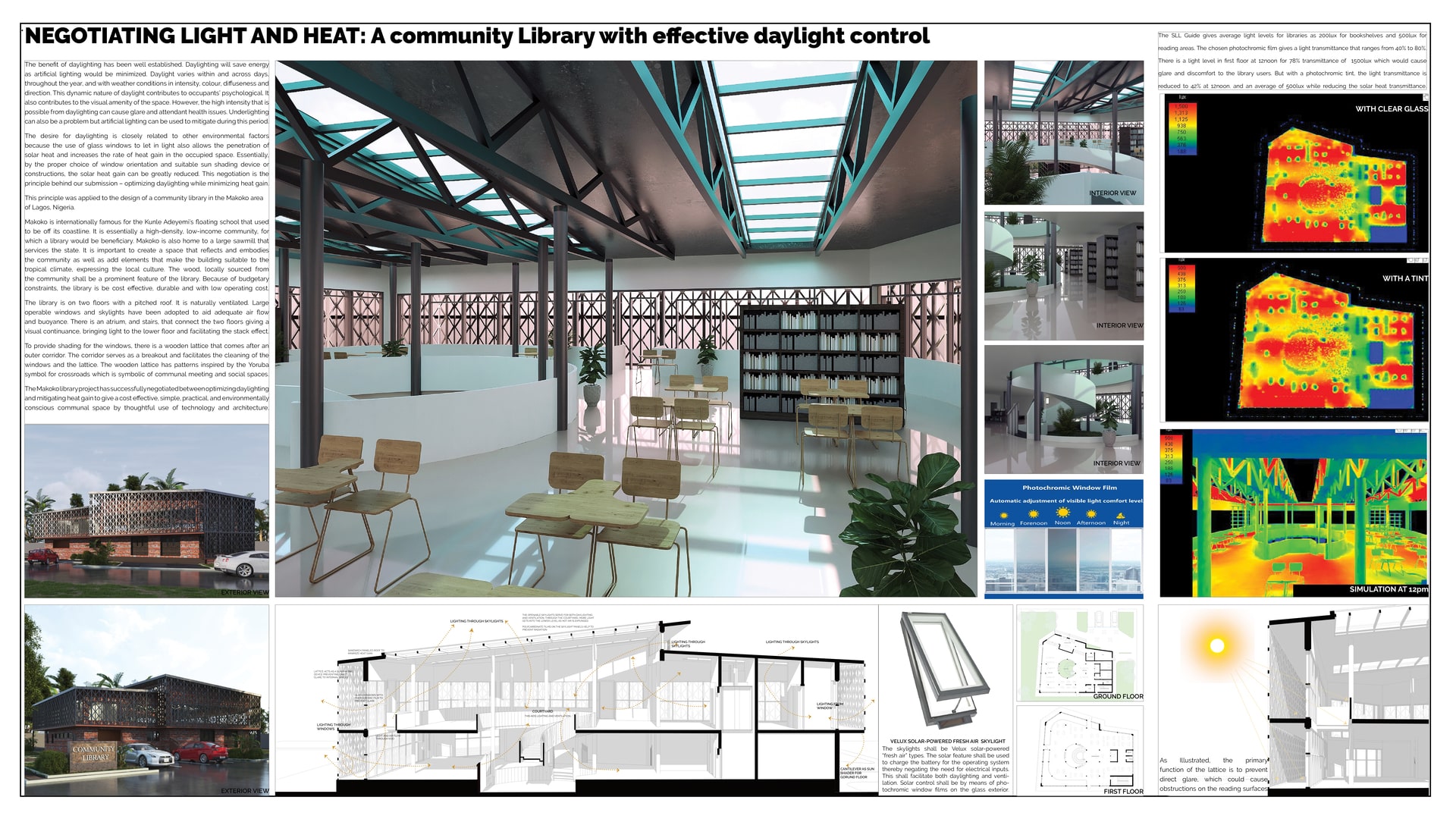Project Description
NEGOTIATING LIGHT AND HEAT A community library with effective daylight control INTRODUCTION The benefit of daylighting has been well established. Daylighting will save energy as artificial lighting would be minimized. Daylight varies within and across days, throughout the year, and with weather conditions in intensity, colour, diffuseness and direction. This dynamic nature of daylight contributes to occupants’ psychological. It also contributes to the visual amenity of the space. However, the high intensity that is possible from daylighting can cause glare and attendant health issues. Underlighting can also be a problem but artificial lighting can be used to mitigate during this period. The desire for daylighting is closely related to other environmental factors because the use of glass windows to let in light also allows the penetration of solar heat and increases the rate of heat gain in the occupied space. Essentially, by the proper choice of window orientation and suitable sun shading device or constructions, the solar heat gain can be greatly reduced. This negotiation is the principle behind our submission – optimizing daylighting while minimizing heat gain. This principle was applied to the design of a community library in the Makoko area of Lagos, Nigeria. THE LIBRARY PROJECT Makoko is internationally famous for the Kunle Adeyemi’s floating school that used to be off its coastline. It is essentially a high-density, low-income community, for which a library would be beneficiary. Makoko is also home to a large sawmill that services the state. It is important to create a space that reflects and embodies the community as well as add elements that make the building suitable to the tropical climate, expressing the local culture. The wood, locally sourced from the community shall be a prominent feature of the library. Because of budgetary constraints, the library is be cost effective, durable and with low operating cost. Lagos has a tropical climate (Aw) with average maximum temperatures of 28-33oC. Being close to the sea, it is very humid. It averages over 1800 hours of sunshine. The library is on two floors with a pitched roof. It is naturally ventilated. Large operable windows and skylights have been adopted to aid adequate air flow and buoyance. There is an atrium, and stairs, that connect the two floors giving a visual continuance, bringing light to the lower floor and facilitating the stack effect. To provide shading for the windows, there is a wooden lattice that comes after an outer corridor. The corridor serves as a breakout and facilitates the cleaning of the windows and the lattice. The wooden lattice has patterns inspired by the Yoruba symbol for crossroads which is symbolic of communal meeting and social spaces. The skylights shall be Velux solar-powered “fresh air” types. The solar feature shall be used to charge the battery for the operating system thereby negating the need for electrical inputs. This shall facilitate both daylighting and ventilation. Solar control shall be by means of photochromic window films on the glass exterior. The roof of the building has insulated sandwich panel to reduce the heat transmission to the space. DAYLIGHTING SIMULATION The daylighting simulation was carried out using the Velux Daylight Visualizer Tool. The SLL Guide gives average light levels for libraries as 200lux for bookshelves and 500lux for reading areas. The chosen photochromic film gives a light transmittance that ranges from 40% to 80%. The light level in first floor at 12noon for 78% transmittance reaches 1500lux. This will cause glare in the space and discomfort to the library users. With a photochromic tint which has reduced the light transmittance to 42% at 12noon, the lighting level is an average of 500lux. The film also reduces the solar heat transmittance. In the early mornings and late evenings when the sun is low in the sky, the tint of film is lighter, thereby increasing the light transmittance. At the time that the sun is low in the sky, the vertical lattice shading are more effective in reducing the solar effect of the daylight while passing adequate light to the space. The design has been able to optimize the daylighting inside the library while mitigating heat gain. Artificial lighting, controlled by daylight sensors, will come on if the daylighting level is low especially during the rainy season when there is overcast. CONCLUSION The Makoko library project has successfully negotiated between optimizing daylighting and mitigating heat gain to give a cost effective, simple, practical, and environmentally conscious communal space by thoughtful use of technology and architecture.
